Food for the Soul: Cerca Trova in Florence
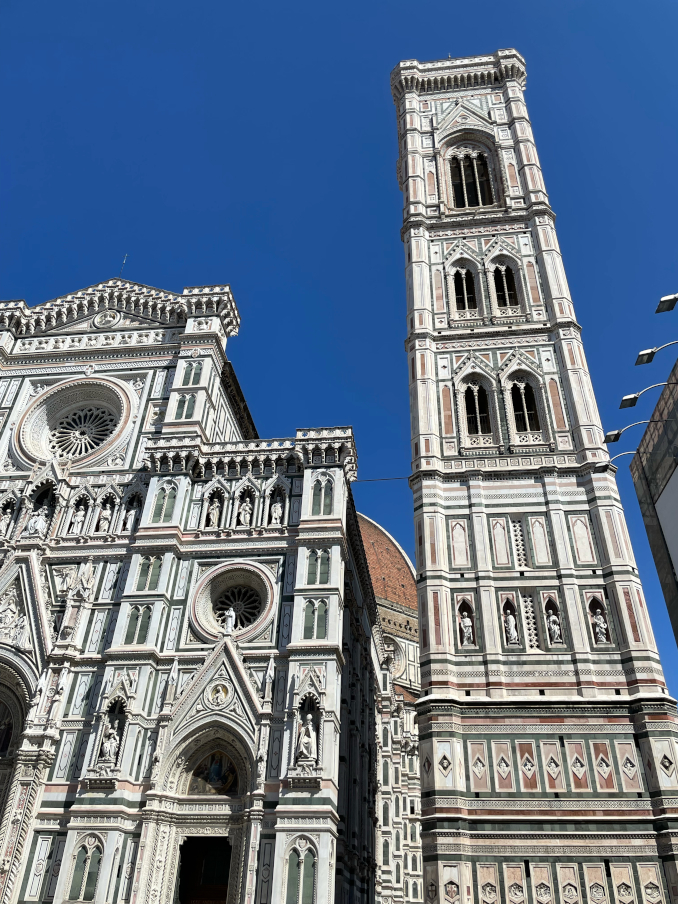
Florence cathedral. Photo: Nina Heyn
By Nina Heyn – Your Culture Scout
In 1504, when Leonardo da Vinci was mostly done with living in Florence, he accepted an important commission to decorate Palazzo Vecchio (which served as the meeting hall for the Florentine Grand Council) with a fresco depicting the historic Battle of Anghiari fought in 1440. The Council also commissioned Michelangelo to decorate the opposite wall with a fresco of the 1364 Battle of Cascina. As fate would have it, neither of these assignments ended up being completed. Michelangelo had barely made a preparatory cartoon when he was summoned to Rome to work on the tomb of the new pope, Julius II. Da Vinci worked on the Anghiari project for about two years, experimenting with wax paints under oil, but after the paint streaked from the candle heat, he abandoned the ruined project. Thanks to other artists’ copies and drawings based on da Vinci’s studies for his Battle of Anghiari (with the most famous one being by Rubens), we know what da Vinci’s fresco was supposed to look like, but the actual design is not there. Or is it?
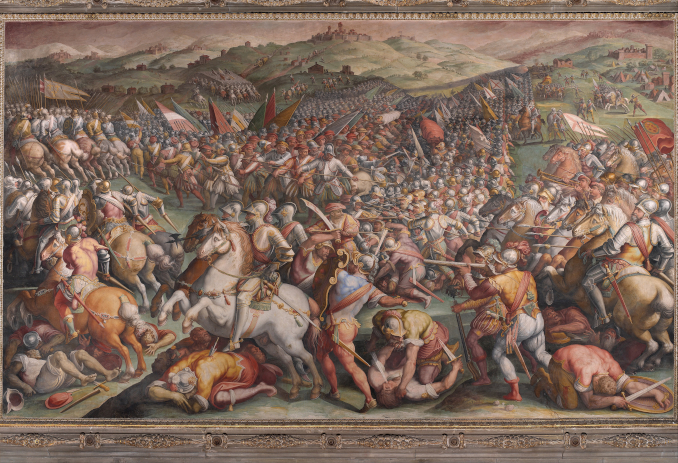
Giorgio Vasari. Detail from The Battle of Marciano (1570-1571). Palazzo Vecchio, Florence. Photo: Wikimedia Commons
There is a legend that Giorgio Vasari, the Medicis’ court artist, hid da Vinci’s fresco behind a false wall in Palazzo Vecchio. (Vasari is particularly famous as the author of the first anthology of Florentine old masters, called The Lives of the Artists, which is the foundation of Renaissance art history.) Vasari was tasked with decorating the hall’s old walls, but apparently he was reluctant to cover the venerated master’s art, so he created a new wall in front of da Vinci’s work. In the Palazzo’s huge “Hall of the Five Hundred,” Vasari covered large surfaces with frescos glorifying events from Florentine history. The fresco depicting the 1554 Battle of Marciano contains a mysterious inscription, cerca trova (“he who seeks, will find”), placed on one of the flags that is far into the enormous battle scene. This motto is really well hidden from the casual viewer—actually about 12 feet from the viewer’s eye.
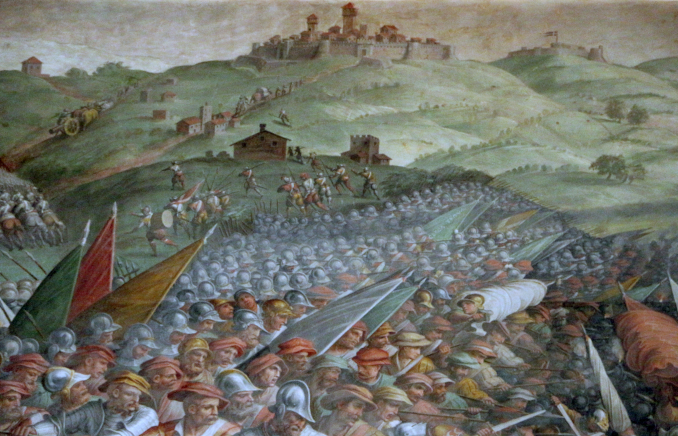
Georgio Vasari. Detail from The Battle of Marciano (1570-1571). Palazzo Vecchio, Florence. Photo: Wikimedia Commons
Da Vinci fans took this as a clue to finding The Battle of Anghiari. In 2011-2012, there was even an attempt to drill through Vasari’s wall to allow a small snake camera to explore the space, but so far, the results have been inconclusive, and the mystery remains.
We can use this admonition to look for hidden details to highlight some other little art treasures hiding in plain sight among Florence’s well-known masterpieces. Although the Duomo’s cupola and the city’s palazzos and museums have been photographed and described by every visitor in every possible way, it is still possible to focus on little details and discover tales that surround Florence’s art.
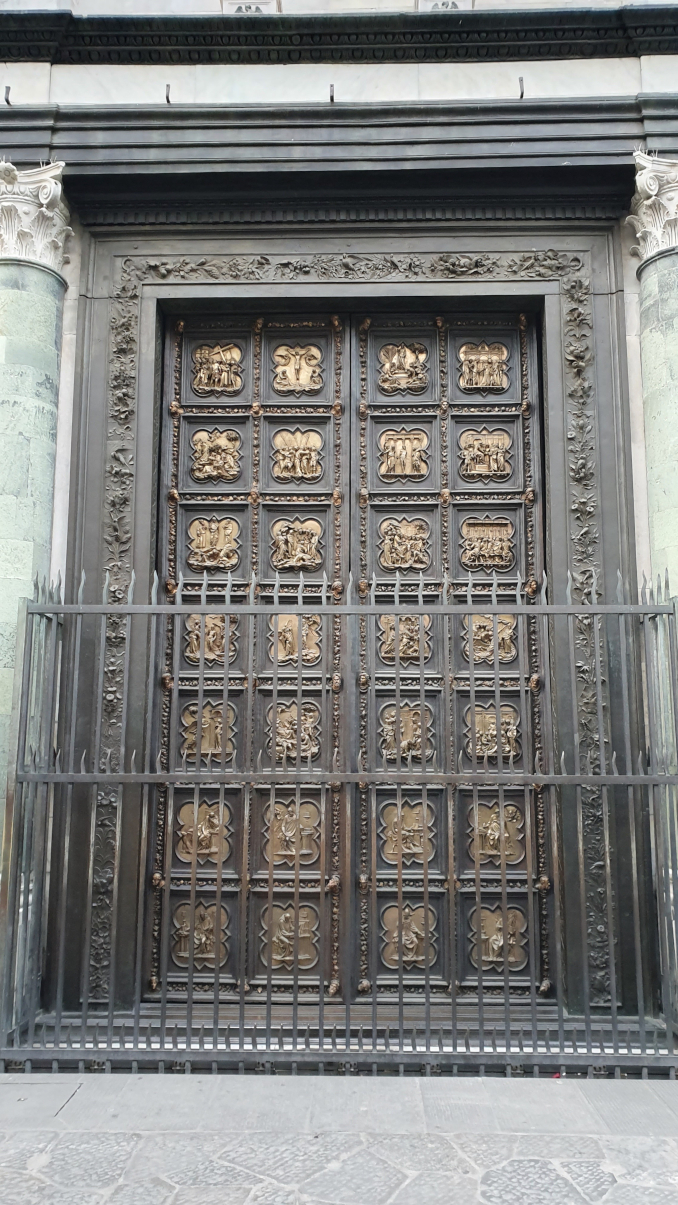
Lorenzo Ghiberti. North Door of the Baptistery (actually a copy; the original is inside Opera Duomo Museum). Florence. Photo: Wikimedia Commons
One way to measure the difficulty of an artistic competition is to look at the losing entry. In 1401, Florence’s powerful and rich wool merchants’ guild announced a competition to create bronze panels of the door in the famous octagonal Baptistery of St. John. Filippo Brunelleschi submitted this piece:
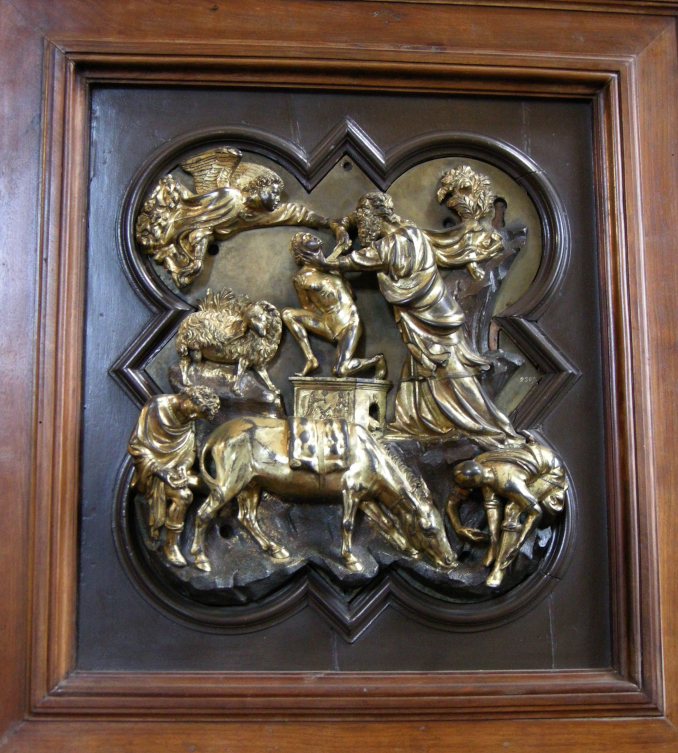
Filippo Brunelleschi. The Sacrifice of Isaac, competition panel for the Northern Doors of the Baptistery (1401). Bargello Museum, Florence. Photo: Wikimedia Commons
One would think that Brunelleschi’s entry is extraordinarily beautiful…which it is…except that the winning piece by Ghiberti looked like this:
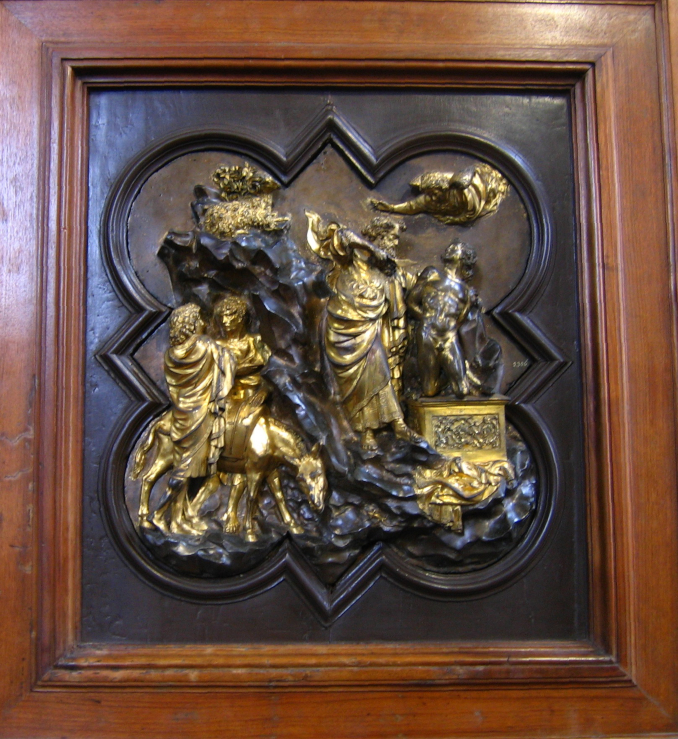
Lorenzo Ghiberti. The Sacrifice of Isaac, winning panel for the Northern Doors of the Baptistery (1401). Bargello Museum, Florence. Photo: Richardfabi/Wikimedia Commons
Ghiberti used his metalsmithing skills to tell a story of an incomplete filicide as a drama in motion, full of dynamic arrangements. His figures are grouped around a diagonally sliding rock while Isaac is straining on his knees and facing us in the eternal pose of any restrained victim. The angel that will stay Abraham’s obedient hand is leaning dramatically out of a panel.
In contrast, Brunelleschi placed the same required elements all in equal measurements around the square (he later became one of the greatest architects of the Renaissance, and organizing space was clearly how his mind worked). Nothing moves in his panel—these are beautiful sculptures but they do not make up an “action shot.” Brunelleschi was so put out by losing this prestigious artistic battle that he left for Rome, learned architecture, and then came back 20 years later to get his vengeance by building Florence’s Duomo—a marvel of construction that awes the world to this day.
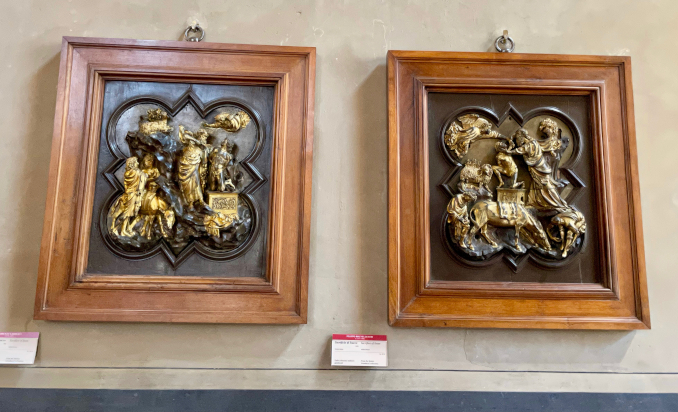
Lorenzo Ghiberti and Filippo Brunelleschi. Detail from competition panels (1401). Bargello Museum, Florence. Photo: Nina Heyn
Both of these original competition panels are now displayed side by side at the Bargello, a museum that houses treasures of sculpture and the applied arts, many of them removed from public spaces after increasing pollution endangered their existence.

Façade of the Basilica of Santa Croce, Florence. Photo: Nina Heyn
The Basilica of Santa Croce, usually the first stop on any walking tour of the city, is recognizable from far away with its white and green marble front. This church serves as one big mausoleum for famous people who were associated with Tuscany. From the much-photographed tombs of Michelangelo, Dante, Rossini, and Galileo to commemorative plaques for da Vinci (who actually worked mostly in Milan and then died in France) and the nuclear physicist Enrico Fermi, the cathedral contains some of the most famous funerary edifices telling the history of Italy.
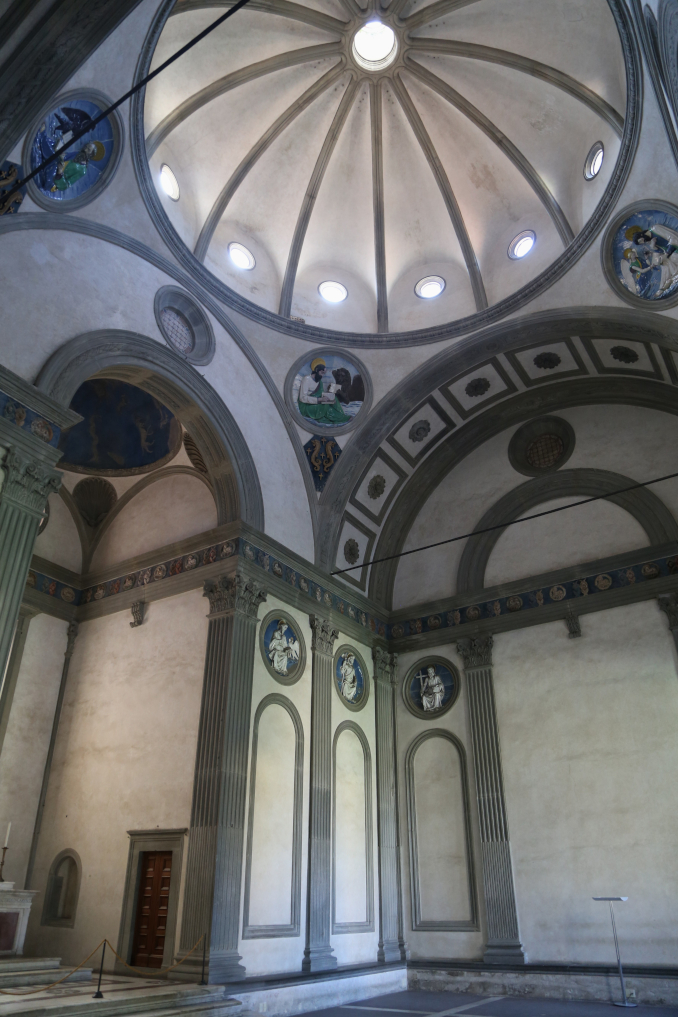
The Basilica of Santa Croce. Pazzi Chapel interior (1443). Florence. Photo: Wikimedia Commons
One of the best parts of this monumental cathedral is actually located on a side of the building, where you can find an austere grey stone chapel founded in 1442 by the Pazzi family. The Pazzi Chapel is considered one of the most graceful buildings in Florence and a masterpiece of Renaissance architecture.
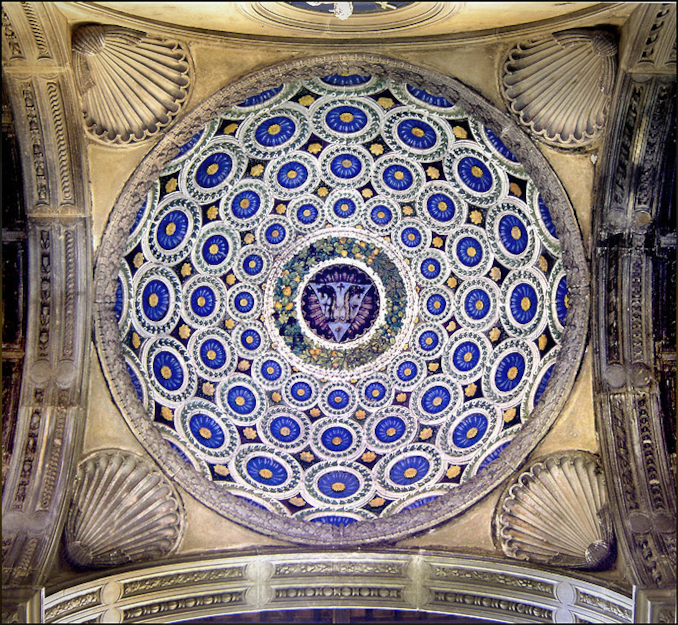
Dome in the Pazzi Chapel. Florence. Photo: Ricard Andre Franz/Wikimedia Commons
The chapel is devoid of frescoes because the Pazzi clan famously self-destructed in 1477 after attacking Lorenzo and Giuliano de’ Medici. The conspiracy failed, the Pazzis were exiled, and the conspirators involved were hung (which da Vinci recorded in a drawing), with the result that the chapel was never covered floor to ceiling with frescoes like all other available surfaces in Florence. The Pazzis did, however, have time to commission Filippo Brunelleschi to create the perfect architectural design for this unusual rectangular hall. The lack of frescoes on walls is actually very refreshing—you can focus on the clean lines of the design without getting distracted by images.

Filippo Brunelleschi. St. Mark (detail). The Pazzi Chapel, Florence. Photo: Nina Heyn
Either Brunelleschi or perhaps Donatello (art historians are not in agreement about which one) also designed four terracotta medallions of the Evangelists that are placed high near the chapel’s supporting arches. One of the medallions features St. Mark, accompanied by a lion who is helpfully holding out a book for the saint. Not only do the folds of the saint’s green give an incredible sense of tri-dimensional space, but the whimsical lion makes it a very humanizing image.
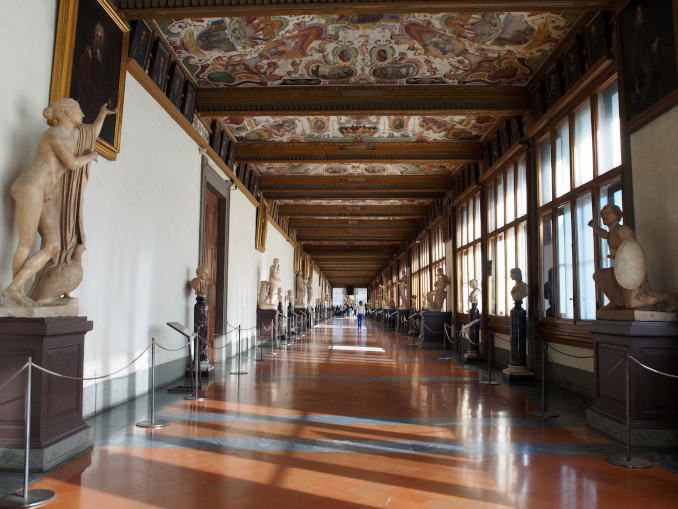
View of the outer corridor of L’Uffizi. Florence. Photo: Petar Milosevic/Wikimedia Commons
The place to get distracted by if not totally immersed in images is the Uffizi Gallery—one of the oldest art galleries in the world. The depository of hundreds of iconic Renaissance artworks, the Uffizi is a magical place where the outer corridor overlooks the graceful bridges of the Arno river and the panorama of Florence, while the inside halls teem with an explosion of art created in Tuscany.
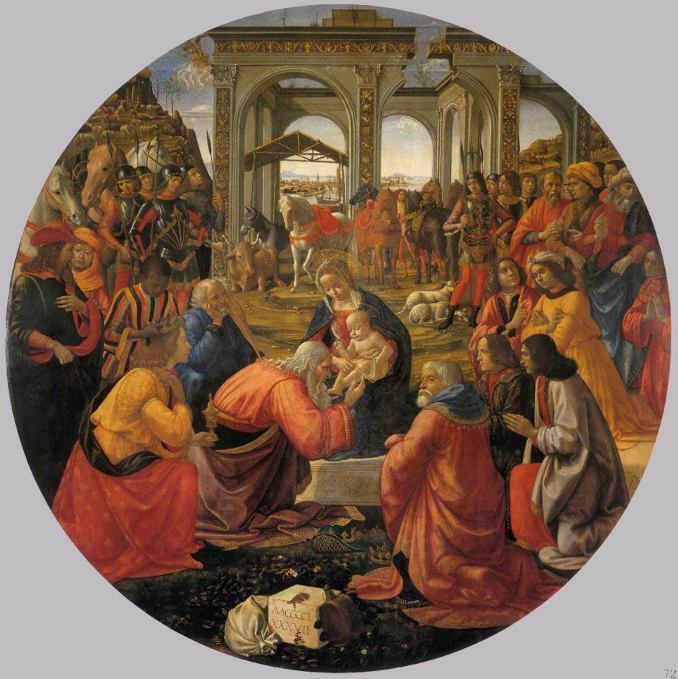
Domenico Ghirlandaio. Adoration of the Magi (1487). L’Uffizi, Florence. Photo: Wikimedia Commons
It is impossible to list the hundreds of paintings displayed in thematic rooms such as a Botticelli room with Primavera and The Birth of Venus, a da Vinci room with Annunciation, or a Raphael room with Madonna of the Goldfinch. Altarpieces are also plentiful there for obvious reasons; however, unlike modern works, these paintings were not designed for museum settings. They were all originally meant to be displayed within the ornate stone and wood surroundings of an altar, with their gilding intended to glitter in the light of candles, inspiring awe in devoted crowds during mass. Artists also created smaller religious paintings for devotional viewing in private rooms and chapels—again, meant to be seen in the light of candles and in an intimate setting.
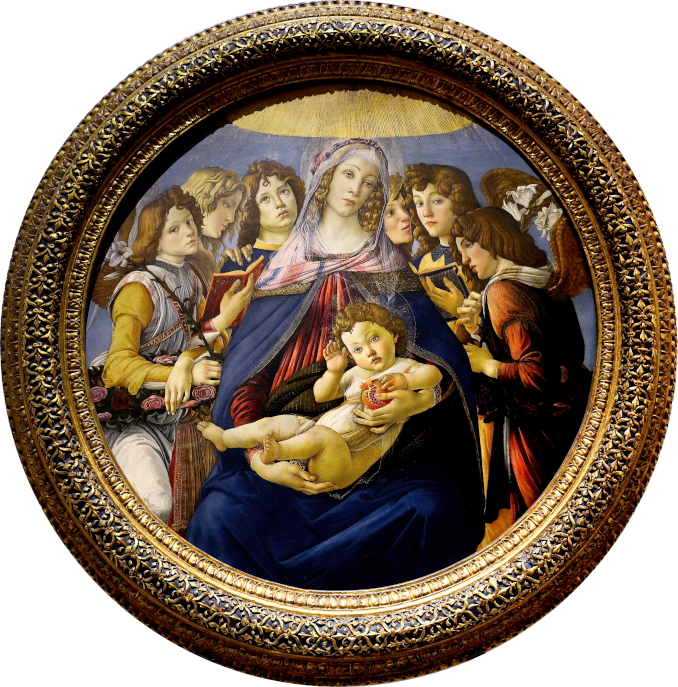
Sandro Botticelli. Madonna of the Pomegranate (1487). L’Uffizi, Florence. Photo: Livioandronico Nanae/Wikimedia Commons
Hundreds of years later, very different adoring crowds come to view these Madonnas, Adorations, and Annunciations as revealed under bright museum lighting, but even so, they still radiate beauty and humanity with every picture.
After feasting one’s eyes on the classics, sometimes it is fun to look at some less popular images. For example, when I did that with Francesco Granacci’s Joseph Presents His Father and Brothers to the Pharaoh, I found a delightful detail in this large, serious painting. Granacci was a Florentine artist who was a student of Ghirlandaio, together with Michelangelo. The two were lifelong friends, sent by Lorenzo de’ Medici to study sculpture. While Granacci never reached the heights of fame of his fellow student, he is an important artist of the period.
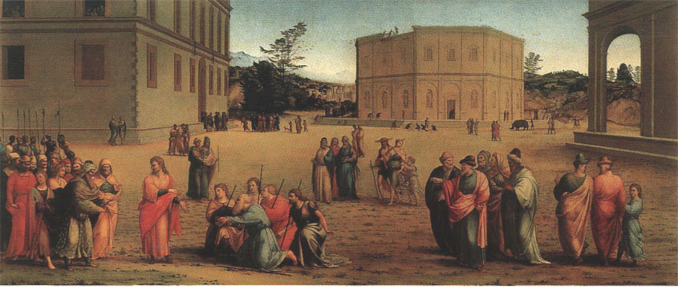
Francesco Granacci. Joseph Presents His Father and Brothers to the Pharaoh (1515). L’Uffizi, Florence. Photo: Wikimedia Commons
In the biblical scene depicting Joseph presenting his relatives to the Pharaoh, Granacci sets his narration in an imaginary Egypt that borrows its architecture from Renaissance Tuscany, complete with a piazza that has at its center an octagonal building very much like the Florentine Baptistery. To make the setting sufficiently “Egyptian,” Granacci dresses his very static figures in “antique” robes and, to top it all off, throws in…a rhinoceros.
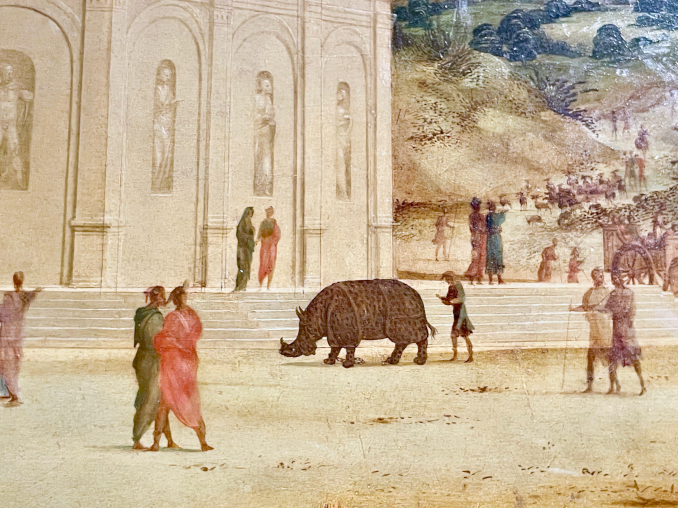
Francesco Granacci. Detail from Joseph Presents His Father and Brothers to the Pharaoh (1515). L’Uffizi. Photo: Nina Heyn
The rhino is not a scientifically accurate animal. Granacci clearly had never seen one beyond book illustrations, but what a great flight of fantasy it is in an otherwise very academic, staid painting. By 1517, when Granacci painted this work, the Renaissance’s greats—da Vinci, Raphael, and Michelangelo—had all left the city for the greener pastures of Rome and Milan. The artistic energy of the city and the ebullience of Renaissance art were waning, and you could even be tempted to place this panel in much later eras of historic tableaux. Except for the rhino, perhaps.
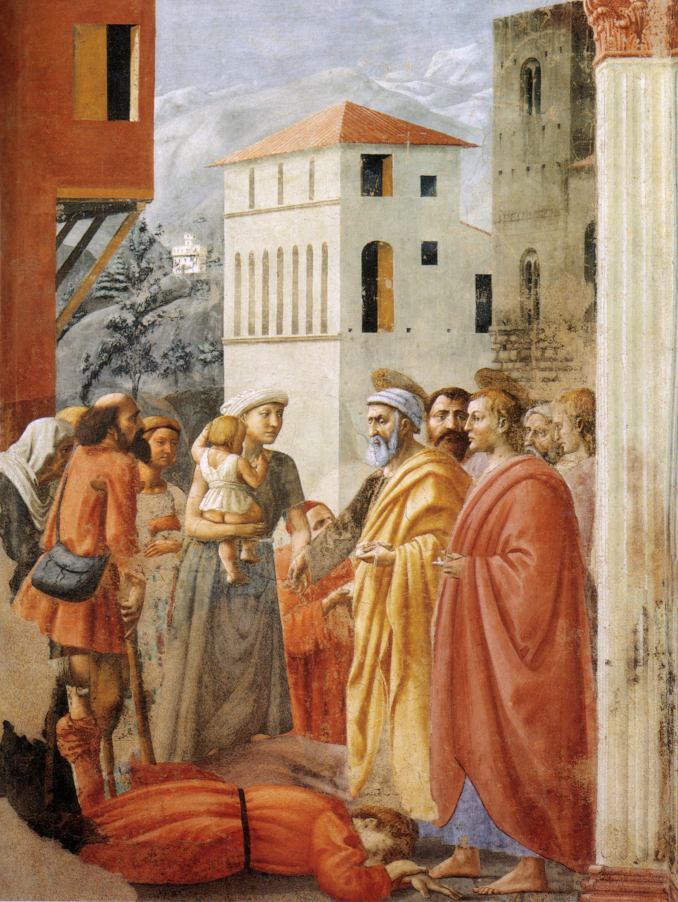
Masaccio. The Distribution of Alms and Death of Ananias (1426-1427). The Brancacci Chapel, Santa Maria del Carmine, Florence. Photo: Wikimedia Commons
Many Florentine artworks are full of these little touches that make serious scenes, religious or historic, a bit more everyday. For example, this is a detail from Masaccio’s Distribution of Alms and Death of Ananias, one of the frescoes that decorated the Brancacci Chapel in the church of Santa Maria del Carmine. In 1424, the Carmelite order of monks commissioned an artist named Masolino to decorate their chapel with frescoes from the life of St. Peter, but when Masolino left for Hungary, his younger pupil Masaccio took over. Whereas Masolino’s art was colorful but static, done in the preceding style of International Gothic, his younger collaborator either created or used all the tricks in the Renaissance toolbox—perspective, movement, drama, realism—to imbue his paintings with realism and drama. This is a scene when an early Christian named Ananias fell to the ground after having kept part of the alms to himself instead of distributing them among the community. St. Peter, resplendent in a flowing yellow robe, is now giving the alms to a woman with child. This is a moral tale of reprimand and punishment from the life of a saint, but what we see in the center is a Florentine woman, dressed in contemporary clothes, holding a baby with a naked bottom—in other words, something mundane and realistic.
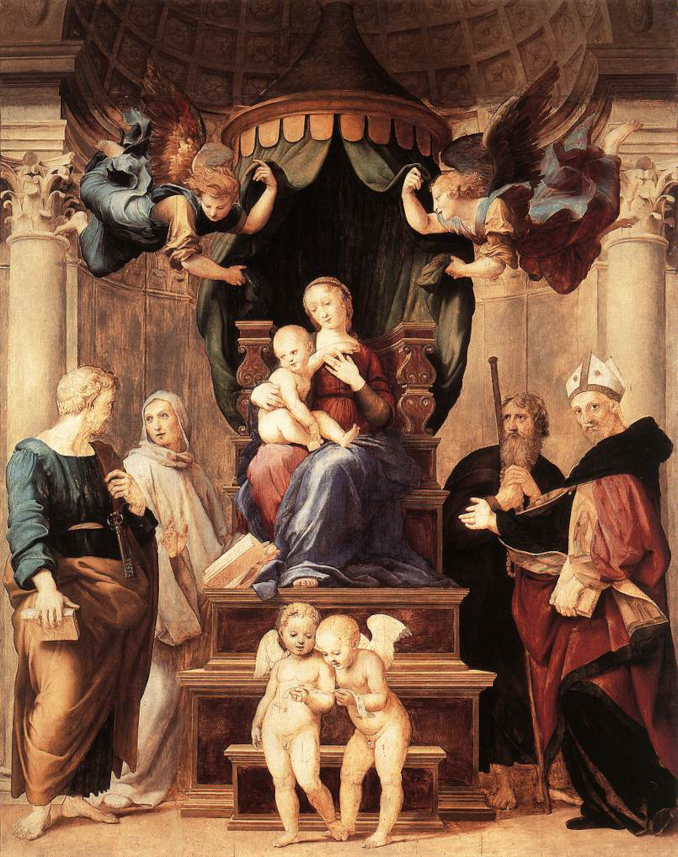
Raphael’s Madonna of the Baldacchino (1507-1508). Palazzo Pitti, Galleria Palatina, Florence. Photo: Wikimedia Commons
Raphael’s monumental Madonna of the Baldacchino hangs at the Pitti Palace’s art gallery, so high (as it would be at the church altar for which it was commissioned in 1508) that all you can see up close are two unfinished but smiling angels. Raphael did not finish this painting, leaving for Rome to work for Pope Julius II on the Vatican frescoes; the artwork, no longer suitable for an altar, was eventually purchased in 1697 by Fernando de’ Medici, who had it completed by brothers Agostino and Niccolo Cassana. It is only the two cherubs singing in the front (while looking at the musical score) who seem to have never been covered with the final paint, but this is what makes them now stand out and charm the viewer.
Renaissance art, mostly religious, is full of symbols and hidden messages. Sometimes these remained unnoticed by the majority of viewers, especially the uneducated (who may not have picked up on references to mythology or the history of Florence). However, the symbolism of flowers (such as the white lily—an emblem of the Virgin Mary—or a red carnation for love) and some gestures (such as a raised finger to symbolize blessing) would have been obvious to all. When we look at the same canvases and frescoes today, a lot of the old symbolism may once again be lost on the casual viewer. What we can pick up on and admire instead is the mastery of color and composition or…we can enjoy those quirky details that can delight the modern viewer regardless of the centuries that separate us from the time of Florence’s greatest artistic blossoming.
